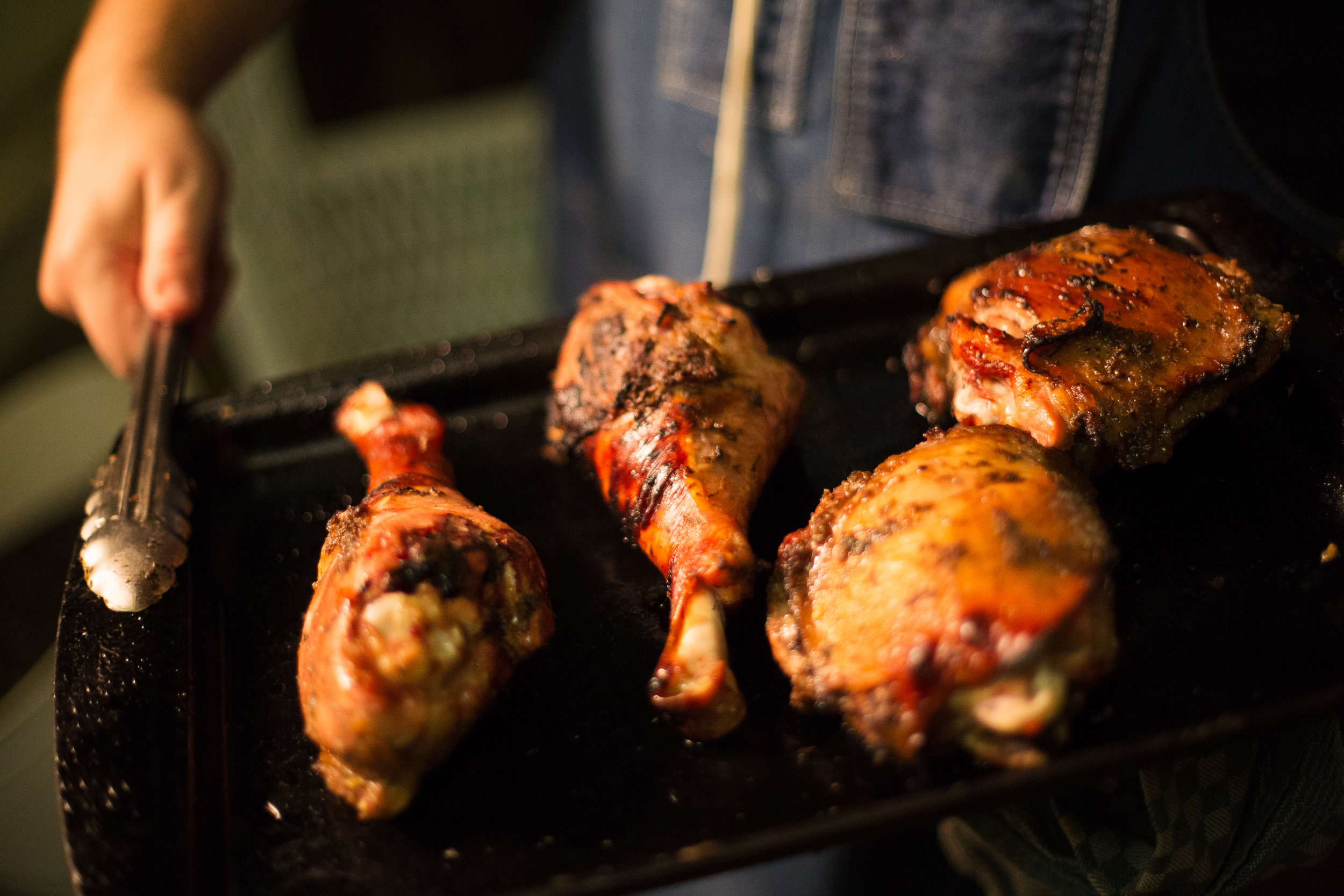Welcome to A Very GBH Thanksgiving. This week, we’re using our Provisions category as an excuse to indulge a’la the season: five courses—soup/salad, vegetable side dish, starch, main dish, dessert—over five days, with some tasty beverages sprinkled along the way.
A pair of our most food-centric writers—one in London, one in Chicago—are teaming up to create this GBH-endorsed Thanksgiving feast. Please enjoy, make it your own, and don’t forget to show some gratitude over the next couple weeks.
—Austin L. Ray, GBH Editorial Director
Course 1: Warm Mushroom Salad and Toasted Corn Husk Soup
Course 2: Roasted Root Vegetables and Collard Greens
Course 3: Challah Bread Pudding and Mashed Butter Potatoes
Course 4: Jerk Turkey and Spiced Quails with Tahini Sauce
I’m responsible for the “side” turkey for our Thanksgiving meal. My friend Kyle’s mother in law Yvette cooks the main turkey, the ham, the mac and cheese, and the stuffing. I take care of the greens, the mashed potatoes and gravy, the pies, and the side turkey. Since the main bird isn't my concern, I’ve been allowed to experiment a bit before settling in on a regular recipe.
I decided early on to cook my turkey on the grill. My rationale was that the easiest way to avoid too many cooks in the kitchen was for me to stay right the hell out of the kitchen. Early on, I made a grilled turkey with a Vietnamese flavor profile. While that was enjoyed, I kept looking for something else. Eventually, I stumbled on a jerk marinade recipe.
Tahini photo by Josh Smith
Thanksgiving has always been about turkey, but turkey has always been the least joyful part of Thanksgiving. I don’t just mean the flesh—notoriously dry, flavorless, comatic. For the cook, turkey also freights an enormous burden of expectation. You’re charged in the care and keeping of it, as if you were the owner of a purebred dog at Westminster. What degree of bronze is its skin? Is its breast undercooked? How juicy is its thigh meat?
In England, there are special disincentives to cooking turkey for Thanksgiving. Notably, it’s traditionally eaten here during Christmas, for starters. Want it any earlier and you’re likely stuck pre-ordering an expensive bird from the butcher. Then there’s the miniature size of most household appliances: I’ve had turkeys so large, and ovens so small, that the doors only half-closed on a wayward drumstick.
When I worked at a restaurant back in Nebraska, my fellow line cook at the time would occasionally run “jerk pork medallion” as a special. Even in those naive years, I was dubious of the quality of his recipe. Doing my own research, I found the repeated use of lime and soy sauce in jerk marinades. And since lime and soy sauce are core elements of my aforementioned Vietnamese recipe, I decided to give jerk turkey a shot. As soon as I smelled the assembled marinade, I knew I had to change up my go-to side bird.
Jerk is sweet, spicy, salty, bitter, and sour. Add in the fact that, when the turkey is done over a grill, you add a smoky component. The result is a bite that attacks the palate on multiple levels, leaving behind a satisfying conclusion.
And so, for the last few years, I’ve found different ways around turkey. One year I cooked duck breasts sous vide, 14 vacuum-sealed parcels of meat swimming through a tank on my counter like demented fish. Last year was goose, which tasted like luxury but released fountains of fat that flowed tidally across my kitchen. This year, I went for the simplest meat main dish I’ve ever done: quails.
On Thanksgiving Day, a quail is a both a pleasing visual gag and exceptionally low-maintenance. You’ll want to butterfly and marinate your quails overnight, but they need just 20-odd minutes in the oven. They require no fraught babysitting, no thermapen thermometers, no waiting for plastic sensors to pop up. No drama at all.
Hand photo by Josh Smith
A lot of the work for this recipe is done the day before with the marinade. Do yourself a favor, and make sure you have a few necessary tools before starting. You will want to make sure you have a citrus juicer. As a bonus, you’ll get your money’s worth out of the machine in delicious margaritas alone. Buy a good meat thermometer, too, as this will be incredibly helpful later. Have a huge mixing bowl. I know too many people with a dinky mixing bowl and it always baffles me. Most importantly, have some kind of rubber or latex gloves available. The spicy heat of this recipe comes from the habanero pepper. You don’t want that on your hands, where it can quickly get to your eyes and other, ahem, sensitive areas. Use the gloves.
Give all the ingredients a rough chop and add them to a large bowl. From here, I generally blend the mixture with a hand blender until it is puréed. You may also do this in batches using a blender or food processor. If you don’t have any of these instruments, you can use the marinade with roughly chopped herbs and onions. Your turkey may end up showcasing the lime and soy sauce more, but it still will be delicious. In the past, I have not puréed the marinade out of sheer laziness. Reader, it was still great.
The first year I grilled a turkey, I spatchcocked the bird and grilled it whole. I read it cooked the bird faster, and the word phonetically delighted, Kendra, my friend Kyle’s wife. Since the turkey needs to be cooked on indirect heat (heating one half of the grill with gas burners or charcoal, leaving the other half without a direct heat source), I quickly discovered it was a pain in the ass to keep rotating a whole flat turkey to ensure even cooking. Since then, I break the turkey into parts—breast, wings, thighs, legs—before marinating. This allows a lot of flexibility when manipulating the arrangement of meat you have on the grill. And that means you have more control over the different parts of the turkey reaching doneness at the same time.
Plastic wrap photo by Josh Smith
These quails bathe in a fragrant marinade of honey and spices and garlic and harissa, which tenderizes and seasons them. Spatchcocking means they cook even faster than they would otherwise. The birds are small, so you can safely allot two per person. And instead of gravy, a tahini yogurt sauce is dolloped on the side. To go alongside, you could do admirably with a Pale Ale or a Saison or a Brown Ale or nearly anything at all, but Westmalle Dubbel works admirably, its darker intensity a welcome contrast on the table, its esters well-matched by the quail’s spicing and the nuttiness of the tahini.
If these quails have any disadvantage, it’s that their small size makes them fiddly to eat with a knife and fork. Luckily, that’s easily solved: just stack up an extra pile of napkins and encourage your guests to eat with their hands. If you’re going to feast, you might as well indulge your animal heart.
Smoke is an essential component of this recipe. Kyle, the steadfast host of the annual affair, likes a quick grill and a tidy garage and yard. All of which is to say: he doesn’t own a charcoal grill. If you find yourself in a similar position, you will want to create a foil pack with wood chips. Jerk traditionally uses pimento wood in the cooking process. You can order pimento wood chips on Amazon. You can also use any wood chips on hand in a pinch.
If you’re using a grill where you’re unable to fit the whole bird on at once, I suggest cooking the turkey in batches. Start with the legs and thighs, which are the most forgiving, grill over indirect heat to 120-130. Pull and move to a warm oven where they will continue to cook slowly. Then grill the wings, again pulling at 120-130. Wings are also very forgiving, but cook much faster than the thicker thigh and leg. Finally, cook the turkey breasts. The breasts are cooked last since they cook the fastest, and are the least forgiving as compared to the other parts of the bird.
While the breasts cook, keep checking the temperature of the thighs and legs. If they reach 160, wrap in foil and hold on the countertop. The secret to juicy turkey is checking the meat's temperature a lot, and removing from heat when it’s done. However, this only slows down the cooking process. It doesn’t stop it. All turkey parts must reach 165 to be considered safe. I generally tent and rest at 155-160, since the turkey will keep cooking under the foil. When turkey breasts reach this temperature range, tent and let sit to rest for 10-15 minutes.
Many would consider Central State’s Garden the perfect summer beer, but to me it’s just perfect full stop. When I found this beer was still available in late fall, I was simply thrilled. This Leipzig Gose-style brew packs a lot of flavor at 3%, which makes it the perfect companion for a long day of cooking and eating. Garden’s lemon acidity pairs well with the jerk turkey’s marinade, while cutting through the fat and smoke from this dish, as well as its sides. In our first post this week, I talked about focusing on amazing beers that my guests could drink at any time. Garden is a perfect example of that philosophy.
Jerk Turkey
Adapted from Immaculate Bites
12-15 pound turkey
2-3 whole Scotch bonnet peppers
12 scallions, roughly chopped
6 shallots (or 1 large red onion)
4 inches knob fresh ginger, roughly chopped
2 large heads of garlic or 20 or so garlic cloves
4 tablespoons freshly picked thyme leaves
2 tablespoons ground allspice
2 tablespoons cinnamon powder
3 tablespoons freshly ground pepper
3 teaspoons nutmeg
5 tablespoons dark brown sugar
1.5 cups soy sauce
5 tablespoons honey
5 teaspoons maggi sauce
Juice of 10 limes, zest of 3 limes
1/2 cup olive oil
Smoke pack
1/4 cup whole allspice berries
3 dozen dried bay leaves (about 2 loosely packed cups)
Pimento wood (or cherry and hickory)
1. Remove skins of shallot, ginger, and garlic. Roughly chop garlic, scallions, shallot, and ginger. Add to a non-reactive bowl. Add remaining ingredients to same non-reactive bowl and mix.
2. Purée marinade with a hand blender, or in batches in food processor/standing blender.
3. Once done, move to non-reactive, food-safe container or bag. This container or bag should be large enough to fit the whole turkey, but also be able to fit in the refrigerator.
4. Break turkey down into parts, two breast lobes, two wings, two thighs, two legs. Add to marinade.
5. Marinate overnight.
6. Preheat grill to around 350.
7. Cook indirectly on a grill to 155-160. This should take about 60-90 minutes.
8. Tent and rest in a warm place for 10-15 minutes. Turkey must reach 165.
9. Carve and serve as desired.
Spiced Quails with Tahini Sauce
Serves 6
For the quails
12 quails
Fine sea salt, to taste
½ cup (120ml) olive oil
1 teaspoon ground cardamom
1 teaspoon ground cloves
1 teaspoon ground cumin
1 teaspoon ground cinnamon
1 teaspoon freshly ground black pepper
5 garlic cloves, smashed
2 tablespoons honey
Zest of 1 lemon
1 teaspoon harissa paste (or more, to taste)
4 tablespoons tepid water
Handful of pomegranate seeds
Pomegranate molasses (optional)
For the tahini sauce
1 garlic clove, minced
3 tablespoons tahini (look for a high-quality tahini with a runny consistency)
3 tablespoons Greek yogurt
Juice of ½ lemon
2 tablespoons water
Pinch of fine sea salt
1. Begin prepping the quails the night before your feast. Use a pair of kitchen shears to cut along both sides of each quail’s backbone. Remove and discard the spine, and gently flatten the bird. Repeat with the remaining quails. Season both sides of the birds well, and place in a large bowl.
2. In a separate bowl, make your marinade. Add the olive oil, ground spices, garlic, honey, lemon zest, and harissa, then whisk to combine. Whisk in the water to help thin the mixture. Pour over the quails and use your hands to mix and ensure they’re all well-coated. Cover and chill overnight.
3. Preheat the oven to 350° Fahrenheit (177° Celsius). Line two baking sheets with foil and place a wire rack over each. Roughly 30 minutes before you plan to cook the quails, remove from the fridge. Divide the quails between the two wire rack-fitted baking sheets. Arrange them so they’re flattened and breast-side up.
4. Roast the quails for approximately 20 minutes, pausing halfway through to rotate the two baking sheets to ensure they cook evenly. The quails are done when their skin is beginning to turn golden. They may be slightly pink along the bone—cook for several minutes longer if you prefer them well done.
5. As the quails roast, make the tahini sauce. Add the garlic clove, tahini, and Greek yogurt to a bowl, then whisk to combine. Pour in the lemon juice and then the water, whisking as you go, until the mixture is uniform and pourable, though still thick. Season to taste with sea salt.
6. To serve, scatter some pomegranate seeds over the quails, and drizzle lightly with pomegranate molasses, if preferred. Serve the tahini sauce on the side.























